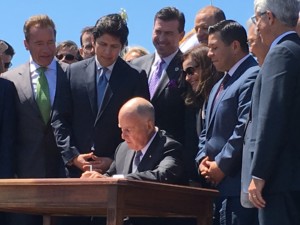10 Things that will Change in California’s New Cap-and-Trade Program
The bipartisan deal to extend California’s cap-and-trade program consisted of three separate bills, and a number of compromises by all parties.
Assembly Bill 398 (AB 398) is the bill that actually extends the cap-and-trade program to 2030. It passed with a two-thirds supermajority vote on July 17, eliminating any concerns about the legality of the revenue generated by the program. AB 398 changes the existing cap-and-trade program in a number of ways, reflecting a desire by the Legislature to be more involved in this significant policy, as well as some accommodations necessary to gain the supermajority.
- Auction prices will be capped at a price ceiling. The Air Resources Board (ARB) will establish a price ceiling for the maximum cost of allowances, at which unlimited allowances will be available. The revenue from those allowances would be used to purchase reductions on a ton-for-ton basis (like offsets) to maintain the integrity of the system.
- Speed bumps will slow the rise of auction prices. The ARB will establish two “speed bumps” where additional allowances are made available to reduce the likelihood of costs racing suddenly to the ceiling price.
- Polluters will continue to receive free allowances. AB 398 maintains the current distribution of free allowances to trade-exposed industries, with the amount declining at the same rate as the cap. This was a major concession to covered entities as before this bill, ARB was in the process of reducing the distribution of free allowances.
- Offsets usage will be reduced. This is a problematic compromise because over 168 forest projects across 29 states, which caused conservation and improved forest management, have been funded by offsets. In the current program, entities can use offsets for up to 8% of their compliance. In AB 398, the limit will be 4% from 2020 through 2025 and 6% from 2026 through 2030. During both periods, half of the offsets must have direct benefits for California.
- ARB will be the only entity to regulate greenhouse gas emissions. Local air districts will be prevented from regulating greenhouse gases from 2020-2030. This is extremely controversial and a major win for the oil and gas companies.
- Refinery greenhouse gas emissions will not be further regulated outside of cap-and-trade. ARB was considering directly reducing refinery emissions by 20% in addition to the cap-and-trade program, but this won’t happen under the new system from 2020-2030. Instead, cap-and-trade will be the sole regulation of refinery and oil production facility greenhouse gas emissions.
- The State Responsibility Area (SRA) Fire Prevention Fee will be repealed. The approximately $80 million of annual revenue from this fee will be backfilled by auction revenue. This action has little to do with climate policy but was a political inducement for some legislators.
- A manufacturing tax credit will be extended and expanded. An existing credit, worth around $90 million annually, will be extended. It will also be expanded it to include generation, production, storage, and distribution of electricity, which might cost nearly $170 million per year from the auction revenues.
- Establishes priorities for auction revenues. The available auction revenue will be allocated after the Legislature returns from recess on August 21 with these new priorities in mind:
(1) Air toxic and criteria air pollutants from stationary and mobile sources
(2) Low- and zero-carbon transportation alternatives
(3) Sustainable agricultural practices that promote the transitions to clean technology, water efficiency, and improved air quality
(4) Healthy forests and urban greening*
(5) Short-lived climate pollutants
(6) Climate adaptation and resiliency*
(7) Climate and clean energy research
*Forest restoration and conservation projects could receive funding under these two priorities.
- Air quality will be improved by directly addressing large emitters and creating new community-level plans.
The Legislature passed a second bill, Assembly Bill 617 (Christina Garcia) that is focused on more fully integrating our greenhouse gas reduction programs with broader air quality improvement efforts and is being hailed as one of the most significant air quality bills in years.
Finally, Republican leader Chad Mayes insisted on placing a constitutional amendment on the June 2018 ballot which would, starting in 2024, direct the auction revenue into a new “reserve” account. Should the constitutional amendment pass in 2018, the distribution of the revenue auction revenue collected after 2024 would be subject to a two-thirds vote. Should this amendment pass, it would create more uncertainty about investments from the auction revenue.
Read more about the promise cap-and-trade legislation holds for forests.

